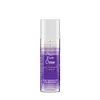What's inside
What's inside
 Key Ingredients
Key Ingredients

 Benefits
Benefits

 Concerns
Concerns

 Ingredients Side-by-side
Ingredients Side-by-side

Water
Skin ConditioningGlycerin
HumectantHamamelis Virginiana Water
AstringentSqualane
EmollientHelianthus Annuus Seed Oil
EmollientCaprylic/Capric Triglyceride
MaskingPPG-3 Benzyl Ether Myristate
EmollientPolysorbate 20
EmulsifyingCetearyl Olivate
Caffeine
Skin ConditioningRibes Nigrum Seed Oil
EmollientCetearyl Alcohol
EmollientPolysorbate 60
EmulsifyingRosa Canina Seed Oil
EmollientAlcohol
AntimicrobialPolyacrylate Crosspolymer-6
Emulsion StabilisingXanthan Gum
EmulsifyingC18-36 Acid Triglyceride
EmollientSorbitan Olivate
EmulsifyingSimmondsia Chinensis Seed Oil
EmollientPerfluorodecalin
Skin ConditioningGluconolactone
Skin ConditioningTartaric Acid
BufferingPhenoxyethanol
PreservativeCaprylyl Glycol
EmollientMagnesium Ascorbyl Phosphate
AntioxidantPolyglyceryl-4 Caprate
EmulsifyingVanilla Planifolia Fruit Extract
Skin ConditioningSodium Benzoate
MaskingTocopheryl Acetate
AntioxidantPentylene Glycol
Skin ConditioningBenzyl Alcohol
PerfumingCitrus Limon Peel Oil
MaskingPalmitoyl Tripeptide-5
Skin ConditioningPhytic Acid
Citrus Aurantium Dulcis Flower Oil
AstringentBenzoic Acid
MaskingSalicylic Acid
MaskingAcetyl Tributyl Citrate
MaskingLecithin
EmollientDehydroacetic Acid
PreservativeTetrasodium EDTA
Citrus Grandis Peel Extract
AstringentCitric Acid
BufferingSodium Hydroxide
BufferingBHT
AntioxidantAcetyl Tetrapeptide-5
HumectantRosmarinus Officinalis Leaf Extract
AntimicrobialPalmitoyl Tetrapeptide-7
Skin ConditioningGlucose
HumectantAstaxanthin
Skin ConditioningCitrus Limon Peel Extract
EmollientChrysin
Skin ConditioningPhenyl T-Butylnitrone
AntioxidantCarrageenan
Water, Glycerin, Hamamelis Virginiana Water, Squalane, Helianthus Annuus Seed Oil, Caprylic/Capric Triglyceride, PPG-3 Benzyl Ether Myristate, Polysorbate 20, Cetearyl Olivate, Caffeine, Ribes Nigrum Seed Oil, Cetearyl Alcohol, Polysorbate 60, Rosa Canina Seed Oil, Alcohol, Polyacrylate Crosspolymer-6, Xanthan Gum, C18-36 Acid Triglyceride, Sorbitan Olivate, Simmondsia Chinensis Seed Oil, Perfluorodecalin, Gluconolactone, Tartaric Acid, Phenoxyethanol, Caprylyl Glycol, Magnesium Ascorbyl Phosphate, Polyglyceryl-4 Caprate, Vanilla Planifolia Fruit Extract, Sodium Benzoate, Tocopheryl Acetate, Pentylene Glycol, Benzyl Alcohol, Citrus Limon Peel Oil, Palmitoyl Tripeptide-5, Phytic Acid, Citrus Aurantium Dulcis Flower Oil, Benzoic Acid, Salicylic Acid, Acetyl Tributyl Citrate, Lecithin, Dehydroacetic Acid, Tetrasodium EDTA, Citrus Grandis Peel Extract, Citric Acid, Sodium Hydroxide, BHT, Acetyl Tetrapeptide-5, Rosmarinus Officinalis Leaf Extract, Palmitoyl Tetrapeptide-7, Glucose, Astaxanthin, Citrus Limon Peel Extract, Chrysin, Phenyl T-Butylnitrone, Carrageenan
Cyclopentasiloxane
EmollientWater
Skin ConditioningIsostearyl Palmitate
EmollientPolyethylene
AbrasiveButylene Glycol
HumectantPolysilicone-11
Ethylene/Acrylic Acid Copolymer
Emulsion StabilisingMorus Bombycis Root Extract
Skin ConditioningCaffeine
Skin ConditioningPhytosphingosine
Skin ConditioningTriticum Vulgare Bran Extract
Skin ConditioningScutellaria Baicalensis Root Extract
AstringentLactis Proteinum
Skin ConditioningOlea Europaea Fruit Extract
BleachingCamellia Sinensis Leaf Extract
AntimicrobialCholesterol
EmollientLinoleic Acid
CleansingTocopheryl Acetate
AntioxidantMagnesium Ascorbyl Phosphate
AntioxidantPyridoxine Dipalmitate
Skin ConditioningSucrose
HumectantGlycerin
HumectantDimethicone
EmollientGlyceryl Laurate
EmollientPEG/PPG-18/18 Dimethicone
EmulsifyingPetrolatum
EmollientCetyl PEG/PPG-10/1 Dimethicone
EmulsifyingPropylene Carbonate
SolventSodium Chloride
MaskingQuaternium-90 Bentonite
Disodium EDTA
Phenoxyethanol
PreservativeIron Oxides
Cyclopentasiloxane, Water, Isostearyl Palmitate, Polyethylene, Butylene Glycol, Polysilicone-11, Ethylene/Acrylic Acid Copolymer, Morus Bombycis Root Extract, Caffeine, Phytosphingosine, Triticum Vulgare Bran Extract, Scutellaria Baicalensis Root Extract, Lactis Proteinum, Olea Europaea Fruit Extract, Camellia Sinensis Leaf Extract, Cholesterol, Linoleic Acid, Tocopheryl Acetate, Magnesium Ascorbyl Phosphate, Pyridoxine Dipalmitate, Sucrose, Glycerin, Dimethicone, Glyceryl Laurate, PEG/PPG-18/18 Dimethicone, Petrolatum, Cetyl PEG/PPG-10/1 Dimethicone, Propylene Carbonate, Sodium Chloride, Quaternium-90 Bentonite, Disodium EDTA, Phenoxyethanol, Iron Oxides
 Reviews
Reviews

Ingredients Explained
These ingredients are found in both products.
Ingredients higher up in an ingredient list are typically present in a larger amount.
Caffeine is most associated with coffee, tea, and cacao. In skincare, it helps with calming inflammation and is rich in antioxidants.
While caffeine is used to treat cellulite and and dark circles, further studies are needed to prove this. It has been believed to help with these skin conditions due to its ability to dilate blood vessels and increase blood flow.
Some studies are looking into caffeine's ability to protect against UV rays.
Learn more about CaffeineGlycerin is already naturally found in your skin. It helps moisturize and protect your skin.
A study from 2016 found glycerin to be more effective as a humectant than AHAs and hyaluronic acid.
As a humectant, it helps the skin stay hydrated by pulling moisture to your skin. The low molecular weight of glycerin allows it to pull moisture into the deeper layers of your skin.
Hydrated skin improves your skin barrier; Your skin barrier helps protect against irritants and bacteria.
Glycerin has also been found to have antimicrobial and antiviral properties. Due to these properties, glycerin is often used in wound and burn treatments.
In cosmetics, glycerin is usually derived from plants such as soybean or palm. However, it can also be sourced from animals, such as tallow or animal fat.
This ingredient is organic, colorless, odorless, and non-toxic.
Glycerin is the name for this ingredient in American English. British English uses Glycerol/Glycerine.
Learn more about GlycerinMagnesium Ascorbyl Phosphate (MAP) is a form of Vitamin C and is an antioxidant. It can help to reduce redness, improve skin texture, reduce the effects of aging, reduce the visibility of dark spots, and brighten skin.
MAP is created by combining ascorbic acid with magnesium salt. While MAP more gentle on the skin than ascorbic acid, it is thought to be less easily-absorbed into the skin.
Due to MAP's stability up to a pH level of 7, it is more stable to air and sunlight exposure than ascorbic acid. The best pH range for MAP is between 5 and 6.
Like other forms of Vitamin C, MAP has been shown to help reduce hyperpigmentation and simulate collagen production.
As an antioxidant, it helps protect your skin against the signs of aging.
Learn more about Magnesium Ascorbyl PhosphatePhenoxyethanol is a preservative that has germicide, antimicrobial, and aromatic properties. Studies show that phenoxyethanol can prevent microbial growth. By itself, it has a scent that is similar to that of a rose.
It's often used in formulations along with Caprylyl Glycol to preserve the shelf life of products.
Tocopheryl Acetate is AKA Vitamin E. It is an antioxidant and protects your skin from free radicals. Free radicals damage the skin by breaking down collagen.
One study found using Tocopheryl Acetate with Vitamin C decreased the number of sunburned cells.
Tocopheryl Acetate is commonly found in both skincare and dietary supplements.
Learn more about Tocopheryl AcetateWater. It's the most common cosmetic ingredient of all. You'll usually see it at the top of ingredient lists, meaning that it makes up the largest part of the product.
So why is it so popular? Water most often acts as a solvent - this means that it helps dissolve other ingredients into the formulation.
You'll also recognize water as that liquid we all need to stay alive. If you see this, drink a glass of water. Stay hydrated!
Learn more about Water